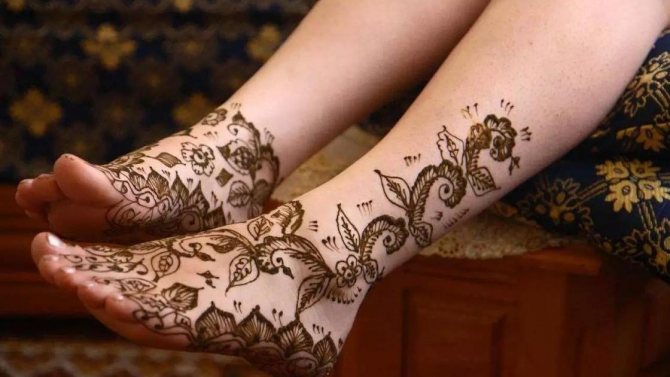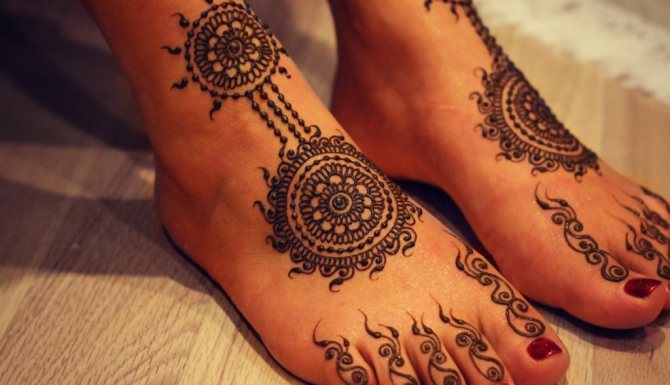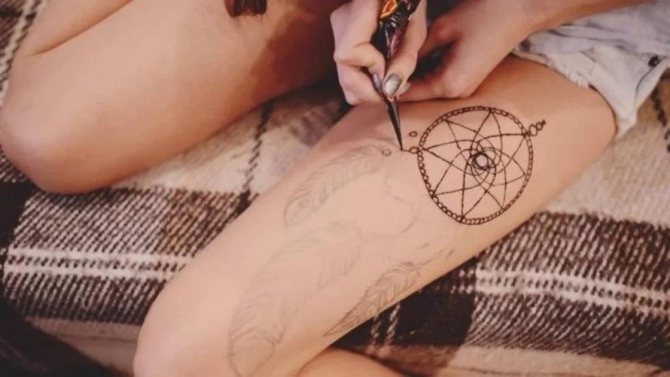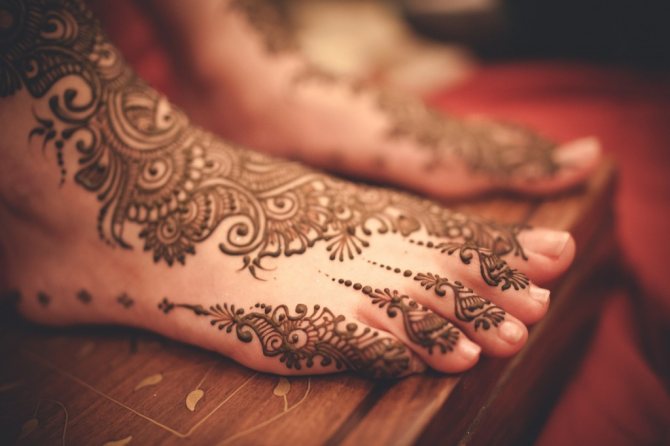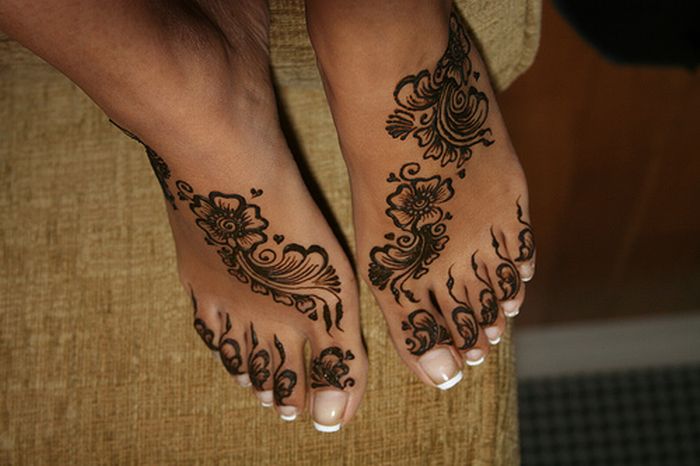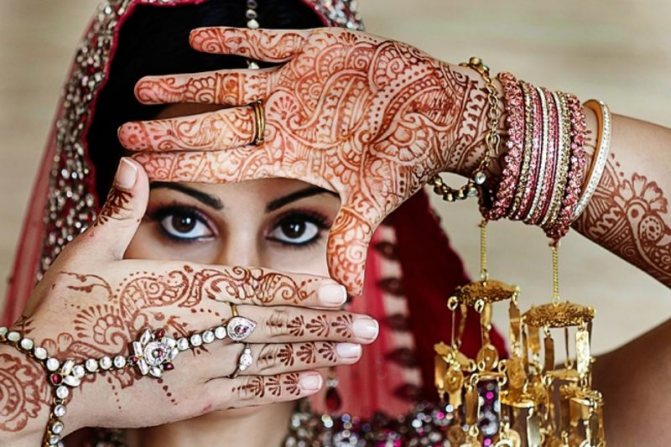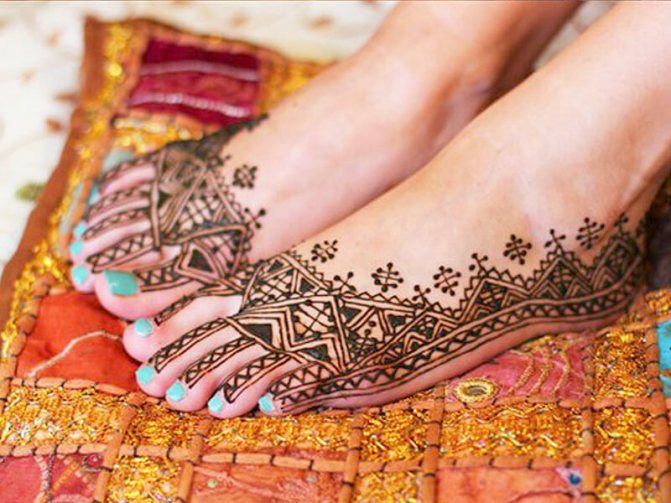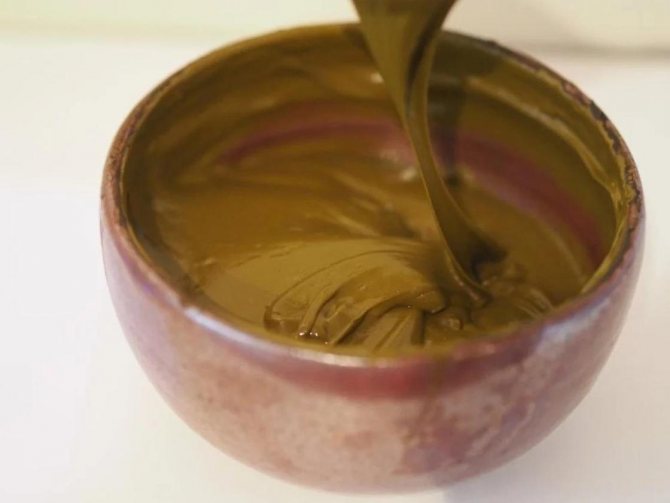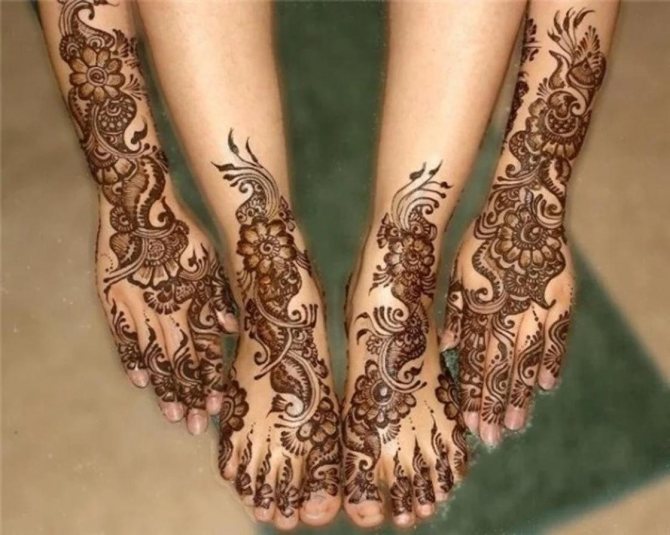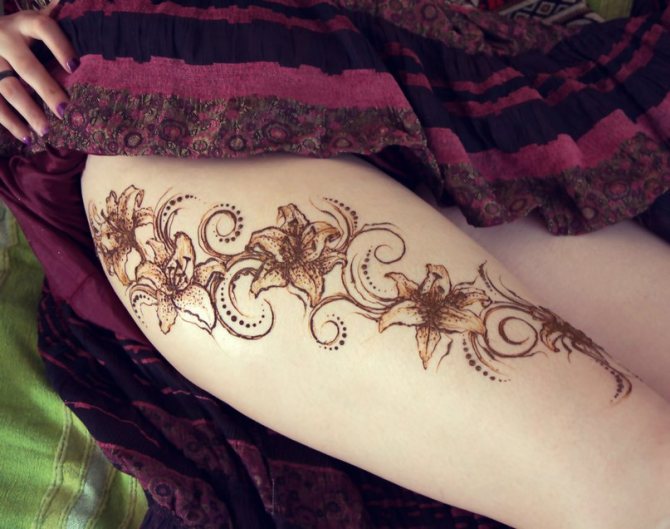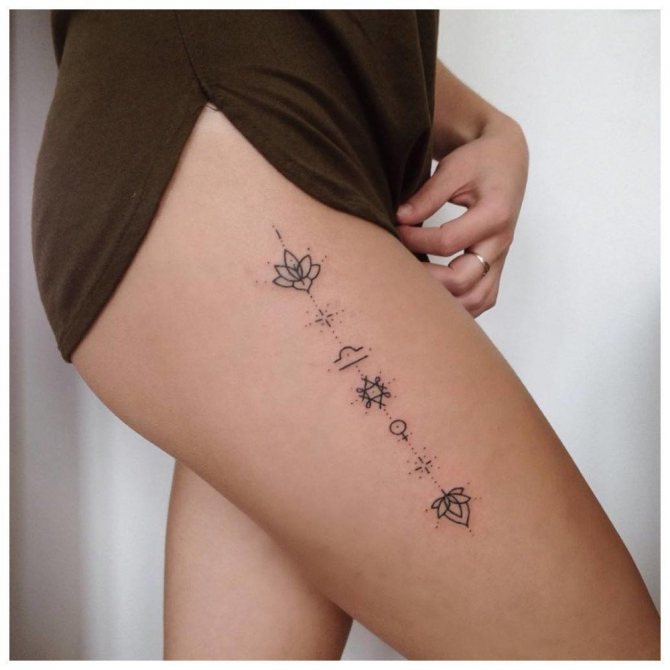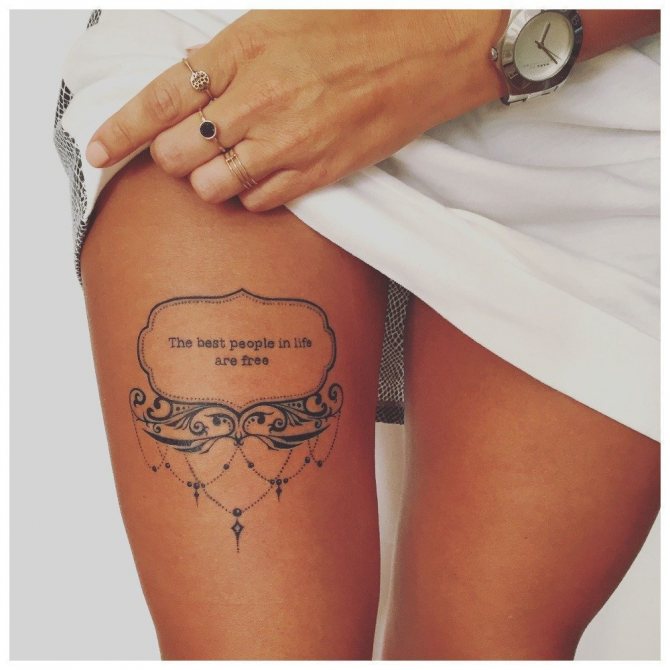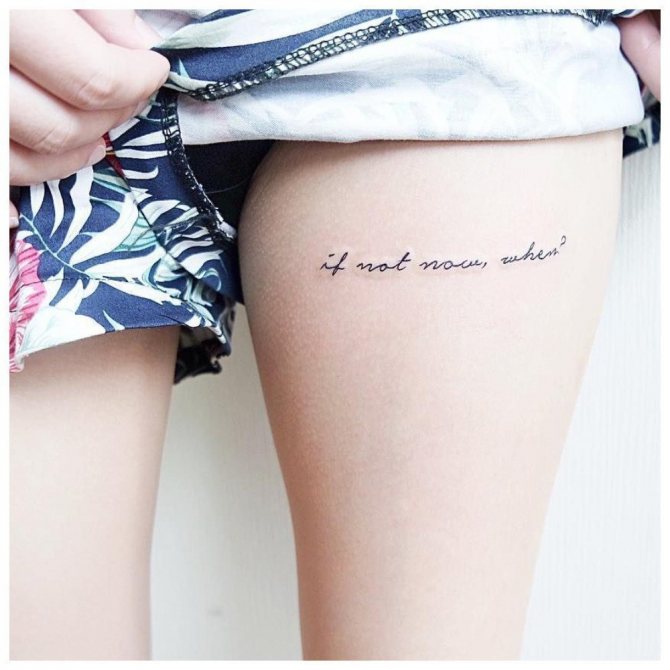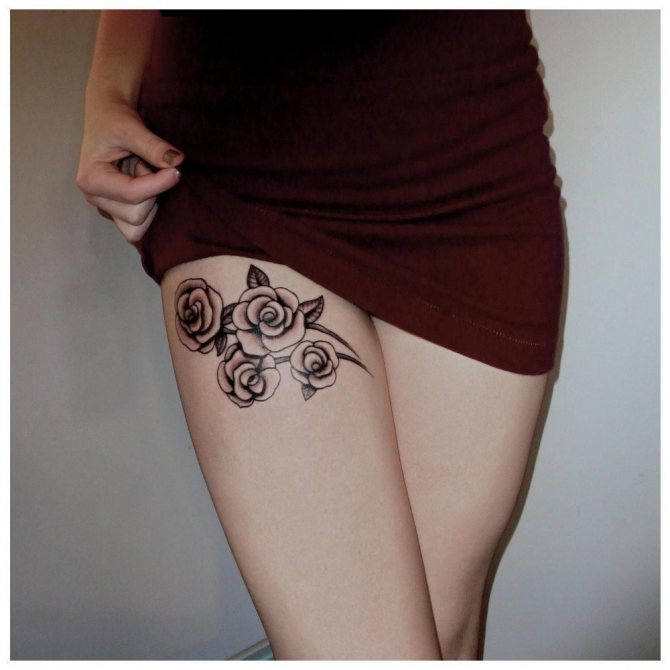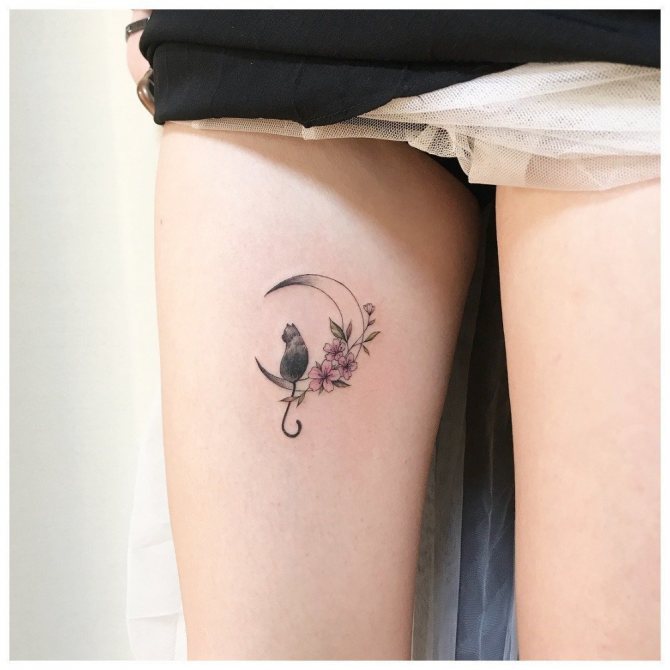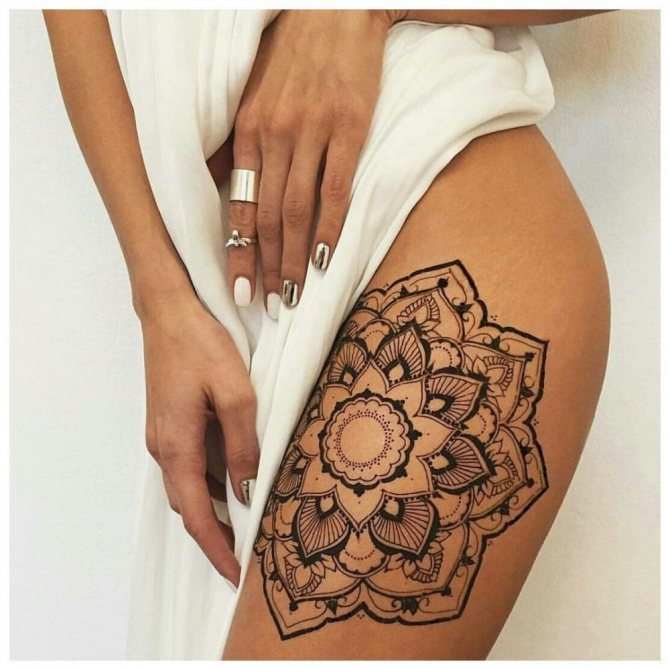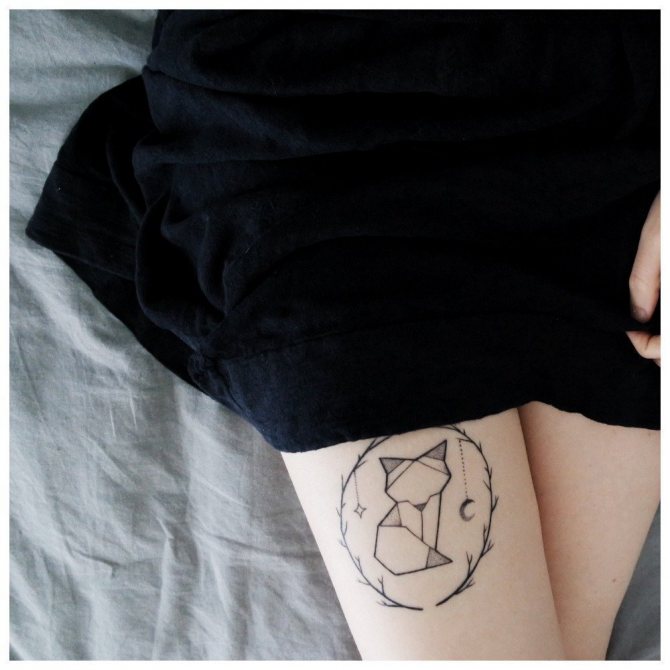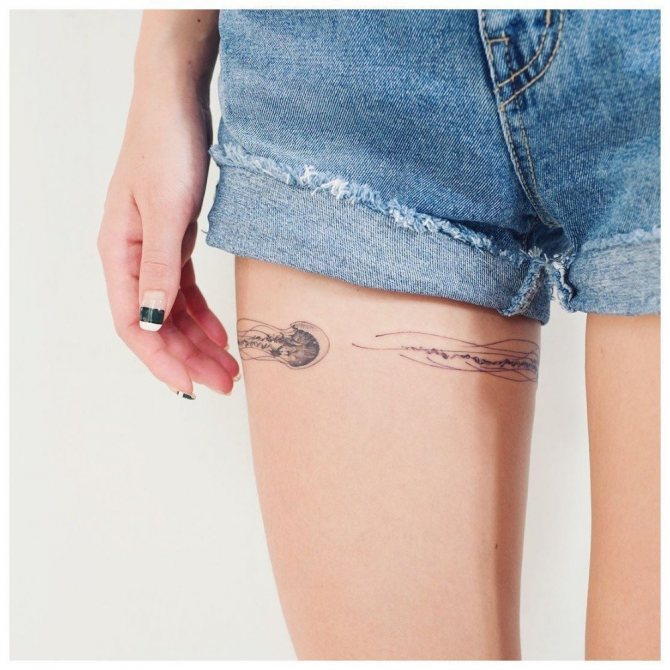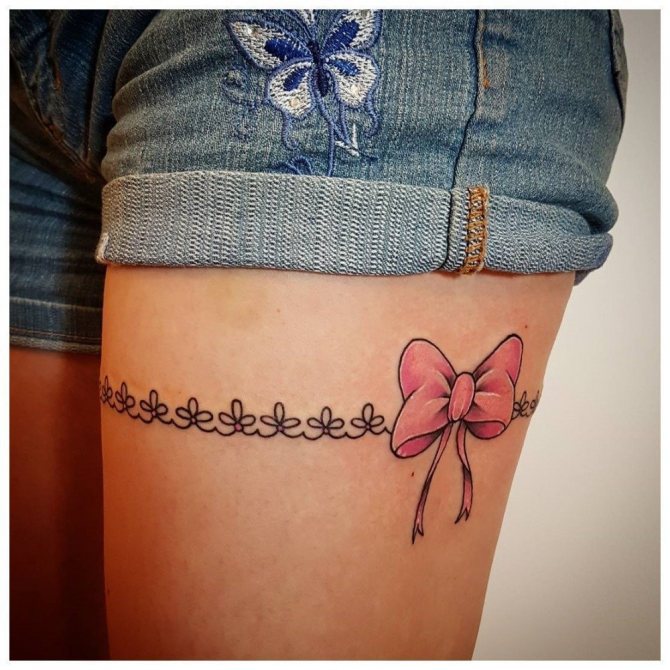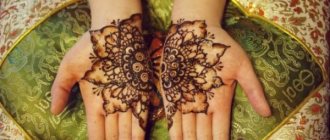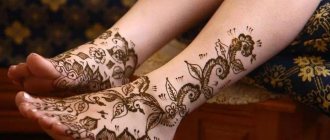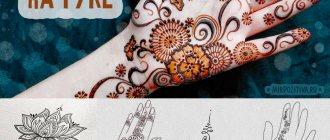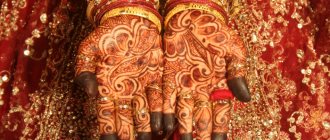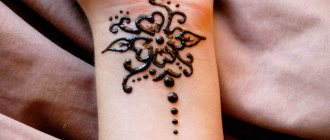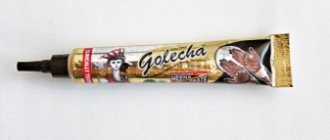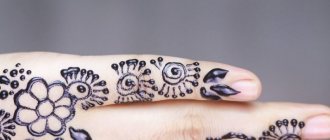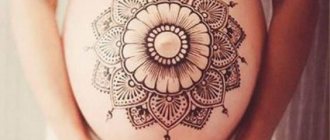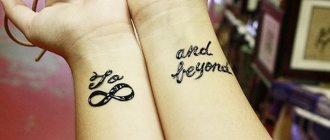Temporary tattoos or henna drawings on the leg called mehendi are most popular in the summertime, when girls bare their bodies. The peculiarity of such tattoos is that they are gradually washed off, which makes it possible to change the illustration every season. The henna picture is drawn manually according to ready-made sketches or using special stencils, which allows people without artistic skills to apply it. How to draw mehendi at home? To do so, it is worth reading the instructions for beginners.
What is mehendi?
Mehendi (mehendi) refers to the Indian painting on the body with henna. It is a temporary tattoo that washes off after a certain period of time. Usually it takes 2-3 weeks for the image to completely disappear from the skin.
It is still unknown where this type of art originated. Currently, there is a statement that for the first time painting appeared in the Arab countries, but, despite this, the greatest popularity of mehendi has received exactly in Europe.

For your information! From reliable sources, it is known that the noble ladies of Ancient Egypt decorated their bodies with mehendi paintings. In India, the henna paintings were used not only as decorations, each of them had its own meaning.
In India, mehendi is traditionally applied to brides before the wedding. It is believed that the patterns depicted by henna, attract good luck.
Temporary tattoos have many varieties. To create some patterns, only outlines are drawn, while other drawings have the objects completely painted on the inside. In addition, depending on established traditions, plant signs, openwork patterns or other motifs are used. Some people prefer to paint individual body parts with henna. Fingers, for example.
What tools are used
To make a henna drawing, you will need:
- dyes of 1-2 colors;
- A bag with a small hole through which the henna will flow onto the skin;
- oils to fix the result;
- Waxless tissues (for blotting the drying dye);
- stencils with a sticky layer;
- lotions, sprays (for deep skin cleansing);
- antiseptic (for preliminary preparation of the area chosen for drawing);
- scrub (for processing);
- A transparent film (to wrap the freshly applied pattern, to ensure deeper penetration of the henna into the skin).
Choosing the right henna for body painting
Two types of henna are used to make mehendi: paste and powder. For beginners, it is better to use the paste, because it is more difficult to work with the powdered composition. Moreover, in the first case, the product comes in cones and is ready for use. As for the powder, it will have to be diluted in certain proportions.
There are two varieties of henna used for mehendi:
- Natural - is a natural dye that is extracted from the leaves of the henna tree;
- Colored - to give a certain color chemical additives are used. It is available in cans or tubes.
On a side note! When you buy henna for mehendi in tubes, it is important to pay attention to the absence of deformations on the package. It should not be swollen, with holes. The packaging is carefully sealed to preserve the soft and slightly fluid structure of the natural dye.
Styles of mehendi drawing
Before choosing an image, you need to determine the style of drawing:
- Arabic - The design uses many floral motifs, and the richness and sophistication of the pattern is welcome;
- African - the most attention is paid to the clear stripes, which should coincide with the lines of the feet;
- Indian - to draw such a pattern is the most difficult, because a large number of complex elements are used to create it, the individual details have a certain meaning;
- Asian - combines in itself Arabian and Indian motifs;
- European - it closely intertwines the traditions of all the above-mentioned styles, it is the youngest trend of mehendi.
For your information! Not only girls, but also men make henna drawings on the leg. However, the representatives of the stronger sex prefer permanent tattoos and choose to apply them to other parts of the body.
Birds
The owl is a symbol of wisdom and knowledge. Even inexperienced masters will be able to draw it.
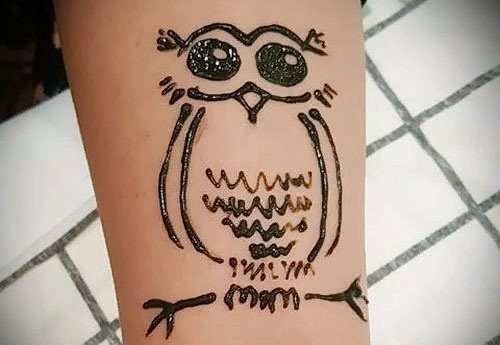

Stages of drawing:
- The head of the owl is a circle.
- From her down to draw an oval, slightly expanding to the base.
- On top of that, add sharp ears.
- At the base of the body to draw 2 small horizontal ovals (paws).
- On the sides of the line wings.
- On the head to draw a large round eyes.
- Owl can be planted on a horizontal branch.
Peacock - a symbol of creativity and free thinking.
A step-by-step plan for depicting the peacock:
- Draw an elongated oval in the middle - the body of the bird.
- Above at some distance to depict a circle - the head.
- Draw a line of the neck.
- On the head to draw an eye and the side - the beak.
- At the bottom left to right to draw the tail feathers.
- At the top decorate circles and curls.
- Down to finish drawing paws.
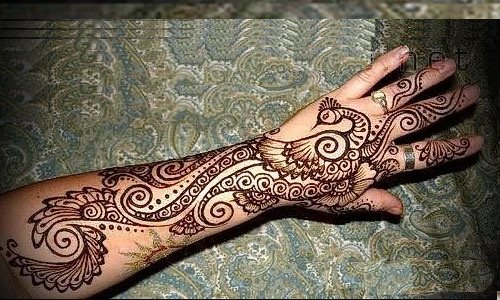

Beginning masters of mehendi will help to apply a henna drawing stencil. It can be made by yourself or use a ready-made sample from a store that sells everything to perform this technique.
Article design: E.Chaikina
The meanings of mehendi patterns: 15 photos
Experts believe that each image carries a certain meaning. Below are pictures of mehendi on the leg and interpretations of the patterns:
- "dream catcher" - usually such a temporary tattoo is applied to the inner side of the ankle, it helps to get rid of insomnia, nightmares that torment at night;
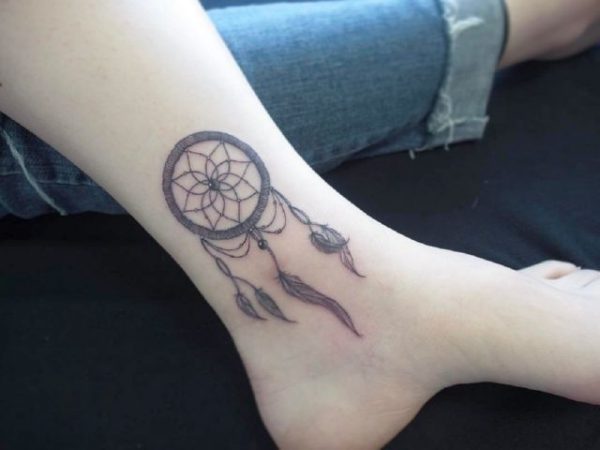

- feather - This picture can be depicted in any part of the leg, it emphasizes the patience and cheerfulness of his owner, gives such features such as courage, wisdom and responsiveness;
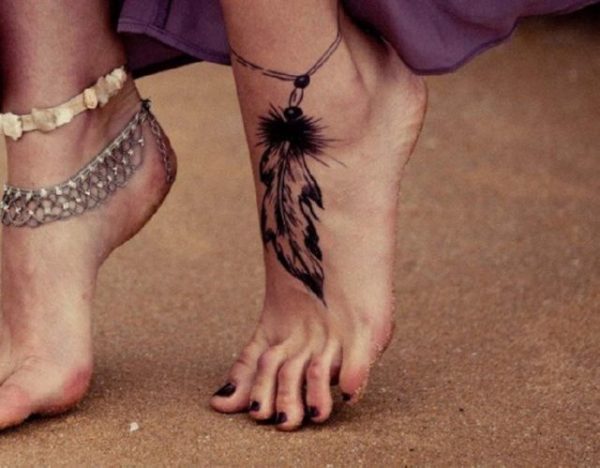

- ankle bracelet - Regardless of what kind of bracelet is displayed around the ankle, it attracts success and helps to achieve their goals;


- lotus - In Oriental peoples the lotus flower is considered holy, often a similar mehengi depicted on the foot, but can be drawn on another part of the leg, the meaning of this symbol varies somewhat among themselves, depending on the number of petals and the complexity of the picture, usually this sign symbolizes wisdom, femininity and sexuality;
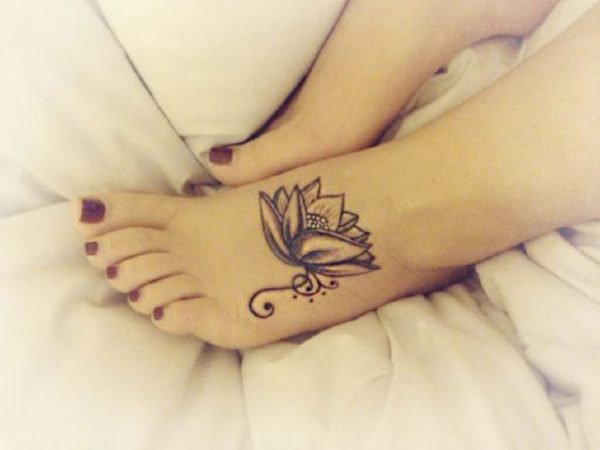

- garter - At this figure is solved only brave women, the tattoo imitates an elastic band stocking and is located in the upper part of the leg, symbolizes the readiness for desperate acts and bright adventures;
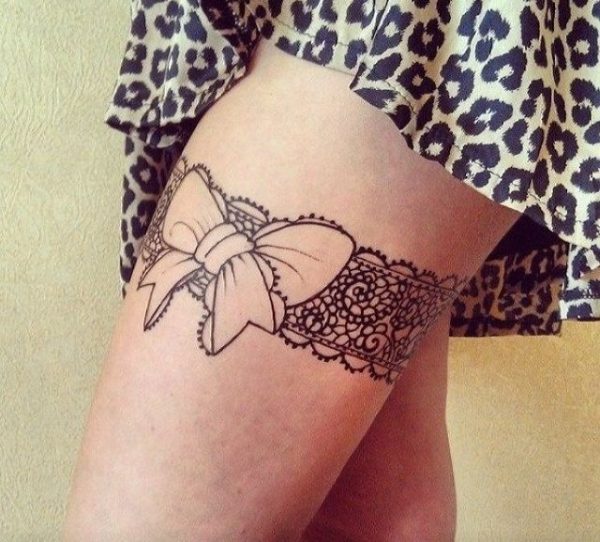

- stars - The image of stars on any part of the leg indicates the desire for harmonious inner development of man;
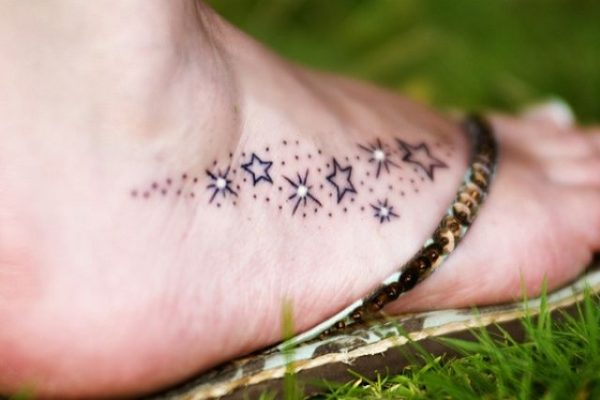

- rhombus - pattern emphasizes emotionality, over-sensitivity and strong sensuality;


- triangle - usually such a temporary tattoo is applied by people who want to show the public the exact definition of the goal and the pursuit of it;


- panther - this sign is preferred to draw a strong women who are confident in their strength, at the same time, it emphasizes grace and following instincts, the fairer sex prefer to draw a wildcat on the ankle, and men - on the calves;
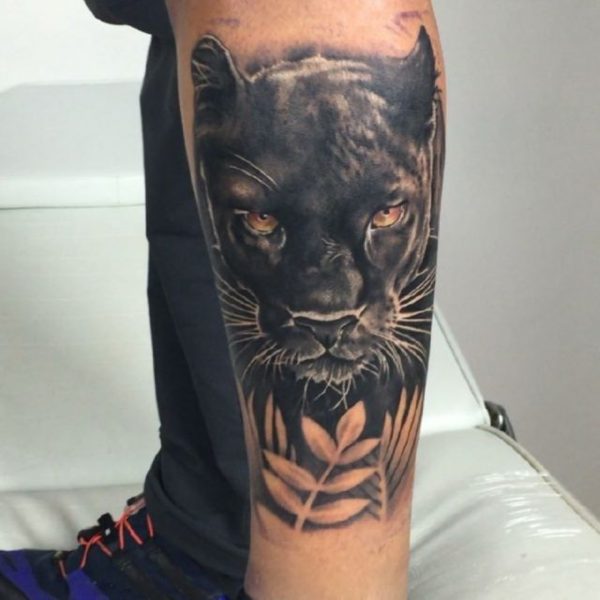

- cat - picture denotes cunning, a tendency to deceit, a desire for independence;
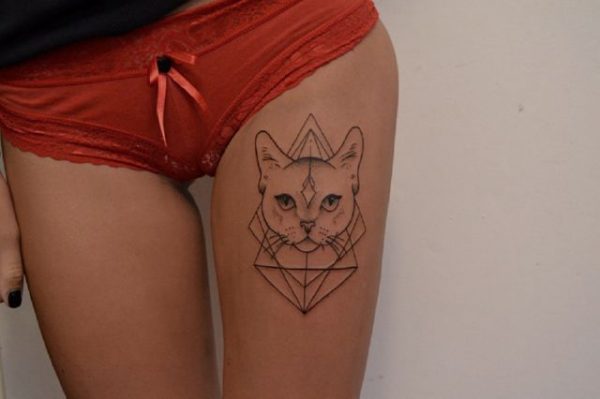

- peacock - The bird indicates greatness, strength of spirit, beauty, but at the same time, emphasizes romanticism, some girls put a henna tattoo in the form of a peacock, to attract fame and fortune, as well as a faithful life partner;
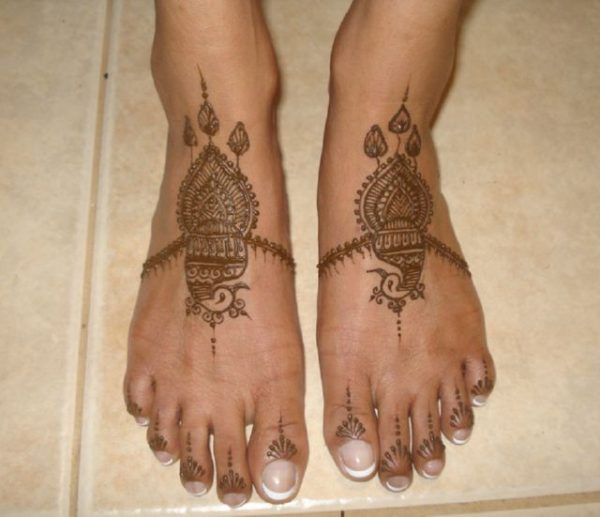

- butterfly - marks the rebirth of a person, just as a caterpillar transforms into a beautiful flying insect;
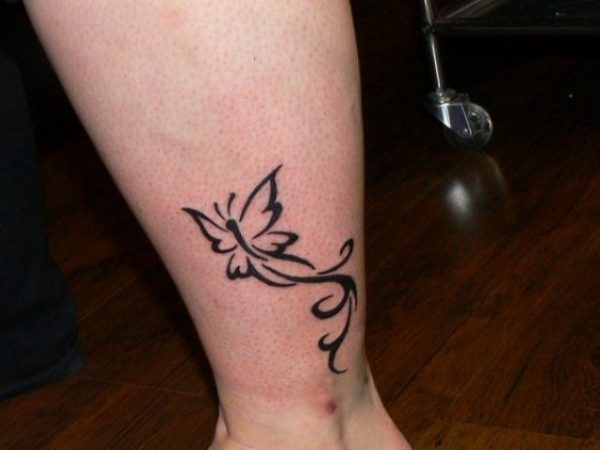

- owl - Usually girls prefer to henna owls on the hips, while men get similar tattoos on the knees and calves, drawing a bird on the leg means deception and false friendship, the owner of this image does not believe his surroundings;


- rose - Rose tattoo can often be seen on the body of girls, draw it henna and on the leg, it is a beautiful flower symbolizes kindness and innocence, and in composition with leaves means prosperity;


- sun - a bright and frequent mehendi symbol that symbolizes warmth, positive energy and belief in a happy life.
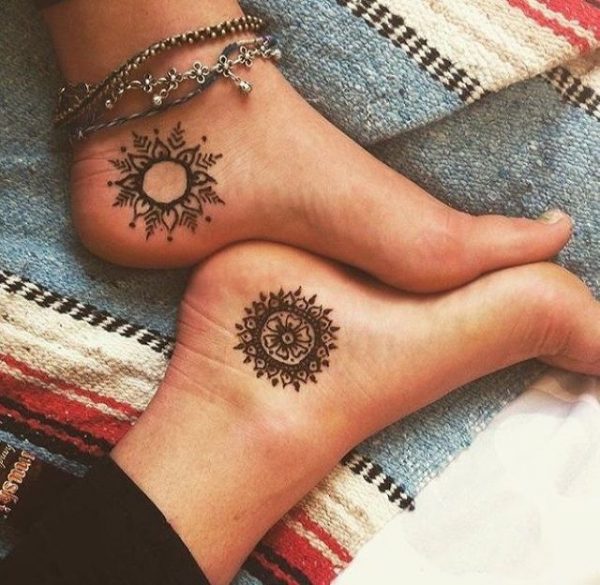

There are other mehendi symbols that are depicted on the foot. They also carry a certain meaning, but are used less frequently than the above signs.
Beautiful mehendi sketches
People who have imagination and artistic skills, draw mehendi on the leg on their own. Those who have been deprived of talent by nature, use ready-made sketches or trace light patterns on stencils.
To find new ideas for performing mehendi on the leg, there are sketches for beginners in the following photos.
Meaning of placement
Since mehendi is not just art, but part of tradition, each drawing carries a specific meaning. The place on the leg where the image is drawn is also not chosen at random:
- on the right leg the right leg is for people who are in a constant search for themselves;
- on the left leg a henna drawing depicts someone who has set a goal and is moving towards it without turning aside;
- on the feet the mehendi is made by selfish people, and on the right leg it means the dissatisfaction of friends, and on the left leg - the lack of support of close people;
- mehendi henna illustration on the shin and ankle has different meanings, it all depends on the specific symbol.
Flowers
The henna drawings (for beginners to comprehend the skill of mehendi is more convenient step by step) are made in parts: originally the main lines are drawn, then the decorations are added. In the process of work come new ideas, so the pattern may be different from what was originally conceived.
The lotus flower is drawn as follows:
- Mark with a dot the bottom of the pattern exactly in the middle.
- From the point to the sides symmetrically draw 2 petals.
- In the middle to draw the central petal, peeking out from under the two already drawn.
- Along the edges add 2 more petals (5 elements).
- Between the central and the first two elements draw 2 petals.
- Connect them with the top center petal.
- Above the first two elements of the drawing of another petal (a total of 10 petals).
- The basis should be supplemented with flowing lines, decorated with curls and dots.
The order of the image of an Indian cucumber:
- The base of the pattern is a drop. The tip is better to slightly twist.
- From the inside repeat the contours of the element.
- At the wide side of the drop to draw a circle (inside you can put Ohm).
- Put dots or small circles between the two contours.
- Decorate the outer contour with "lace" and curls.
A step-by-step plan for drawing the rosebud:
- From the conventional center, draw 2 smooth lines (like the sides of a wide vase).
- One petal to make it wider by drawing a line from the top of the left almost to the base of the right side.
- From the top of the right line to draw a line approximately to the middle of the left petal.
- In the center of the two resulting lower petals hold an arc (unfinished bottom of an oval).
- At the top of the bud draw a horizontal oval.
- Complement the base of the petals, decorate the leaves.
Basic recommendations
Feature of the henna tattoo is not only that it gradually washes off. An important advantage is the possibility of applying mehendi to home conditions. And if on the back and some other parts of the body to do it yourself is not convenient, and sometimes impossible, then on the leg to perform the illustration itself is easier. The main thing is to stick to the technology and follow certain rules:
- about a day before the procedure, refrain from exposure to ultraviolet rays on the area where the pattern is applied;
- Do not apply the pattern to the same area twice in one month;
- not to be exposed to moisturizers before the procedure;
- to remove hair from the place, where it is planned to apply a henna pattern.
On a side note! Experts recommend that beginners, who are going to apply mehendi for the first time, first make a sketch with a gel pen, and only then draw with henna.
Animals
Drawing animals is a little more difficult than drawing plants. If you take it one step at a time, you'll get a fairly acceptable drawing.
The easiest animal to depict is a turtle:
- Draw a horizontal oval, smoothly pointed at the sides.
- Draw 2 parallel lines, repeating the bottom contour.
- Divide with vertical dashes, drawing the shell.
- Add the head on the side.
- Finish drawing the paws on the bottom.
- Decorate the drawing to the taste of the master.
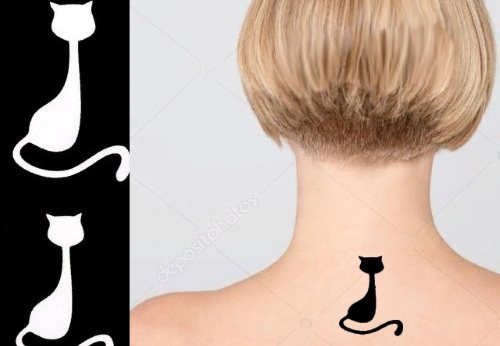

Henna paintings for beginners do not have complicated elements, so you can easily do it yourself
Picture of a sitting cat:
- The muzzle of the cat is a circle or horizontal oval.
- From her downwards draw an oval extending to the base.
- Draw the ears on top.
- At the base of the body draw 2 small horizontal ovals (pads of paws).
- Draw lateral lines, connecting the pads with the top of the body.
- Draw a tail.
- Lines mask with wool.
Step by step drawing of the dragon:
- Draw the top line defining the curve of the dragon's neck, back and tail.
- Draw a muzzle - like a horizontal petal.
- Draw the bottom line, defining the neck, belly and tail.
- On top draw ears, comb or wings.
- Tail decorate comb, spike.
- Underneath, finish drawing the paws.
- Lines mask the scales.
